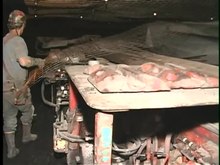Coal mining



Coal mining is the process of extracting coal from the ground. Coal is valued for its energy content and since the 1880s has been widely used to generate electricity. Steel and cement industries use coal as a fuel for extraction of iron from iron ore and for cement production. In the United Kingdom and South Africa, a coal mine and its structures are a colliery, a coal mine is called a 'pit', and the above-ground structures are a 'pit head'. In Australia, "colliery" generally refers to an underground coal mine.
Coal mining has had many developments over the recent years, from the early days of men tunneling, digging, and manually extracting the coal on carts to large open cut and long wall mines. Mining at this scale requires the use of draglines, trucks, conveyors, hydraulic jacks and shearers.
The coal mining industry has a long history of significant negative environmental impacts on local ecosystems, health impacts on local communities and workers, and contributes heavily to the global environmental crises, such as poor air quality and climate change. For these reasons, coal has been one of the first fossil fuels to be phased out of various parts of the global energy economy. Most major coal producing countries, such as China, Indonesia, India and Australia, have not reached peak production, with production increases replacing falls in Europe and USA.[1]
History[]
The history of coal mining goes back thousands of years, with early mines documented in ancient China, the Roman Empire and other early historical economies. It became important in the Industrial Revolution of the 19th and 20th centuries, when it was primarily used to power steam engines, heat buildings and generate electricity. Coal mining continues as an important economic activity today, but has begun to decline due to the strong contribution coal plays in global warming and environmental issues, which result in decreasing demand and in some geographies, peak coal.
Compared to wood fuels, coal yields a higher amount of energy per mass and can often be obtained in areas where wood is not readily available. Though it was used historically as a domestic fuel, coal is now used mostly in industry, especially in smelting and alloy production, as well as electricity generation. Large-scale coal mining developed during the Industrial Revolution, and coal provided the main source of primary energy for industry and transportation in industrial areas from the 18th century to the 1950s. Coal remains an important energy source.[2] Coal is also mined today on a large scale by open pit methods wherever the coal strata strike the surface or are relatively shallow. Britain developed the main techniques of underground coal mining from the late 18th century onward, with further progress being driven by 19th century and early 20th-century progress.[2] However, oil and gas were increasingly used as alternatives from the 1860s onward.
By the late 20th century, coal was, for the most part, replaced in domestic as well as industrial and transportation usage by oil, natural gas or electricity produced from oil, gas, nuclear power or renewable energy sources. By 2010, coal produced over a fourth of the world's energy.[3]
Since 1890, coal mining has also been a political and social issue. Coal miners' labour and trade unions became powerful in many countries in the 20th century, and often, the miners were leaders of the Left or Socialist movements (as in Britain, Germany, Poland, Japan, Chile, Canada and the U.S.)[4][5] Since 1970, environmental issues have been increasingly important, including the health of miners, destruction of the landscape from strip mines and mountaintop removal, air pollution, and coal combustion's contribution to global warming.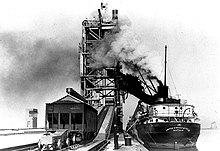
Methods of extraction[]
Coal extraction methods vary depending on whether the mine is an underground mine or a surface (also called open cast) mine. Additionally, coal seam thickness and geology are factors in the selection of a mining method. The most economical method of coal extraction for surface mines is the electric shovel or drag line. The most economical form of underground mining is the long wall, which is a shear blade that runs along sections of the coal seam. Many coals extracted from both surface and underground mines require washing in a coal preparation plant. Technical and economic feasibility are evaluated based on the following: regional geological conditions; overburden characteristics; coal seam continuity, thickness, structure, quality, and depth; strength of materials above and below the seam for roof and floor conditions; topography (especially altitude and slope); climate; land ownership as it affects the availability of land for mining and access; surface drainage patterns; groundwater conditions; availability of labor and materials; coal purchaser requirements in terms of tonnage, quality, and destination; and capital investment requirements.[6]
Surface mining and deep underground mining are the two basic methods of mining. The choice of mining method depends primarily on depth, density, overburden, and thickness of the coal seam; seams relatively close to the surface, at depths less than approximately 55 m (180 ft), are usually surface mined.[citation needed]
Coal that occurs at depths of 55 to 90 m (180 to 300 ft) are usually deep mined, but in some cases surface mining techniques can be used. For example, some western U.S. coal that occur at depths in excess of 60 m (200 ft) are mined by the open pit methods, due to thickness of the seam 20–25 metres (60–90 feet). Coals occurring below 90 m (300 ft) are usually deep mined.[7] However, there are open pit mining operations working on coal seams up to 300–460 metres (1,000–1,500 feet) below ground level, for instance Tagebau Hambach in Germany.
Surface mining[]
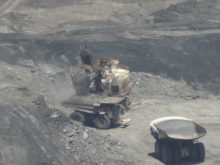
When coal seams are near the surface, it may be economical to extract the coal using open cut (also referred to as open cast, open pit, mountaintop removal or strip) mining methods. Opencast coal mining recovers a greater proportion of the coal deposit than underground methods, as more of the coal seams in the strata may be exploited. This equipment can include the following: Draglines which operate by removing the overburden, power shovels, large trucks in which transport overburden and coal, bucket wheel excavators, and conveyors. In this mining method, explosives are first used in order to break through the surface or overburden, of the mining area. The overburden is then removed by draglines or by shovel and truck. Once the coal seam is exposed, it is drilled, fractured and thoroughly mined in strips. The coal is then loaded onto large trucks or conveyors for transport to either the coal preparation plant or directly to where it will be used.[8]
Most open cast mines in the United States extract bituminous coal. In Canada (BC), Australia and South Africa, open cast mining is used for both thermal and metallurgical coals. In New South Wales open casting for steam coal and anthracite is practiced. Surface mining accounts for around 80 percent of production in Australia, while in the US it is used for about 67 percent of production. Globally, about 40 percent of coal production involves surface mining.[8]
Strip mining[]
Strip mining exposes coal by removing earth above each coal seam. This earth to be removed is referred to as 'overburden' and is removed in long strips. The overburden from the first strip is deposited in an area outside the planned mining area and referred to as out-of-pit dumping. Overburden from subsequent strips is deposited in the void left from mining the coal and overburden from the previous strip. This is referred to as in-pit dumping.[citation needed]
It is often necessary to fragment the overburden by use of explosives. This is accomplished by drilling holes into the overburden, filling the holes with explosives, and detonating the explosive. The overburden is then removed, using large earth-moving equipment, such as draglines, shovel and trucks, excavator and trucks, or bucket-wheels and conveyors. This overburden is put into the previously mined (and now empty) strip. When all the overburden is removed, the underlying coal seam will be exposed (a 'block' of coal). This block of coal may be drilled and blasted (if hard) or otherwise loaded onto trucks or conveyors for transport to the coal preparation (or wash) plant. Once this strip is empty of coal, the process is repeated with a new strip being created next to it. This method is most suitable for areas with flat terrain.[citation needed]
Equipment to be used depends on geological conditions. For example, to remove overburden that is loose or unconsolidated, a bucket wheel excavator might be the most productive. The life of some area mines may be more than 50 years.[9]
Contour mining[]
The contour mining method consists of removing overburden from the seam in a pattern following the contours along a ridge or around the hillside. This method is most commonly used in areas with rolling to steep terrain. It was once common to deposit the spoil on the downslope side of the bench thus created, but this method of spoil disposal consumed much additional land and created severe landslide and erosion problems. To alleviate these problems, a variety of methods were devised to use freshly cut overburden to refill mined-out areas. These haul-back or lateral movement methods generally consist of an initial cut with the spoil deposited downslope or at some other site and spoil from the second cut refilling the first. A ridge of undisturbed natural material 15 to 20 ft (5 to 6 m) wide is often intentionally left at the outer edge of the mined area. This barrier adds stability to the reclaimed slope by preventing spoil from slumping or sliding downhill.[citation needed]
The limitations of contour strip mining are both economic and technical. When the operation reaches a predetermined stripping ratio (tons of overburden/tons of coal), it is not profitable to continue. Depending on the equipment available, it may not be technically feasible to exceed a certain height of highwall. At this point, it is possible to produce more coal with the augering method in which spiral drills bore tunnels into a highwall laterally from the bench to extract coal without removing the overburden.[citation needed]
Mountaintop removal mining[]
Mountaintop coal mining is a surface mining practice involving removal of mountaintops to expose coal seams, and disposing of associated mining overburden in adjacent "valley fills." Valley fills occur in steep terrain where there are limited disposal alternatives.[citation needed]
Mountaintop removal combines area and contour strip mining methods. In areas with rolling or steep terrain with a coal seam occurring near the top of a ridge or hill, the entire top is removed in a series of parallel cuts. Overburden is deposited in nearby valleys and hollows. This method usually leaves the ridge and hilltops as flattened plateaus.[7] The process is highly controversial for the drastic changes in topography, the practice of creating head-of-hollow-fills, or filling in valleys with mining debris, and for covering streams and disrupting ecosystems.[10][11]
Spoil is placed at the head of a narrow, steep-sided valley or hollow. In preparation for filling this area, vegetation and soil are removed and a rock drain constructed down the middle of the area to be filled, where a natural drainage course previously existed. When the fill is completed, this underdrain will form a continuous water runoff system from the upper end of the valley to the lower end of the fill. Typical head-of-hollow fills are graded and terraced to create permanently stable slopes.[9]
Underground mining[]
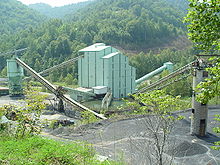
Most coal seams are too deep underground for opencast mining and require underground mining, a method that currently accounts for about 60 percent of world coal production.[8] In deep mining, the room and pillar or bord and pillar method progresses along the seam, while pillars and timber are left standing to support the mine roof. Once room and pillar mines have been developed to a stopping point (limited by geology, ventilation, or economics), a supplementary version of room and pillar mining, termed second mining or retreat mining, is commonly started. Miners remove the coal in the pillars, thereby recovering as much coal from the coal seam as possible. A work area involved in pillar extraction is called a pillar section.[citation needed]
Modern pillar sections use remote-controlled equipment, including large hydraulic mobile roof-supports, which can prevent cave-ins until the miners and their equipment have left a work area. The mobile roof supports are similar to a large dining-room table, but with hydraulic jacks for legs. After the large pillars of coal have been mined away, the mobile roof support's legs shorten and it is withdrawn to a safe area. The mine roof typically collapses once the mobile roof supports leave an area.[citation needed]

There are six principal methods of underground mining:
- Longwall mining accounts for about 50 percent of underground production. The longwall shearer has a face of 1,000 feet (300 m) or more. It is a sophisticated machine with a rotating drum that moves mechanically back and forth across a wide coal seam. The loosened coal falls onto an armored chain conveyor or pan line that takes the coal to the conveyor belt for removal from the work area. Longwall systems have their own hydraulic roof supports which advance with the machine as mining progresses. As the longwall mining equipment moves forward, overlying rock that is no longer supported by coal is allowed to fall behind the operation in a controlled manner. The supports make possible high levels of production and safety. Sensors detect how much coal remains in the seam while robotic controls enhance efficiency. Longwall systems allow a 60-to-100 percent coal recovery rate when surrounding geology allows their use. Once the coal is removed, usually 75 percent of the section, the roof is allowed to collapse in a safe manner.[8]
- Continuous mining utilizes a Continuous Miner Machine with a large rotating steel drum equipped with tungsten carbide picks that scrape coal from the seam. Operating in a "room and pillar" (also known as "bord and pillar") system—where the mine is divided into a series of 20-to-30-foot (5–10 m) "rooms" or work areas cut into the coalbed—it can mine as much as 14 tons of coal a minute, more than a non-mechanised mine of the 1920s would produce in an entire day. Continuous miners account for about 45 percent of underground coal production. Conveyors transport the removed coal from the seam. Remote-controlled continuous miners are used to work in a variety of difficult seams and conditions, and robotic versions controlled by computers are becoming increasingly common. Continuous mining is a misnomer, as room and pillar coal mining is very cyclical. In the US, one can generally cut 20 feet (6 meters) (or a bit more with MSHA permission) (12 meters or roughly 40 ft in South Africa before the Continuous Miner goes out and the roof is supported by the Roof Bolter), after which, the face has to be serviced, before it can be advanced again. During servicing, the "continuous" miner moves to another face. Some continuous miners can bolt and rock dust the face (two major components of servicing) while cutting coal, while a trained crew may be able to advance ventilation, to truly earn the "continuous" label. However, very few mines are able to achieve it. Most continuous mining machines in use in the US lack the ability to bolt and dust. This may partly be because the incorporation of bolting makes the machines wider, and therefore, less maneuverable.[citation needed]
- Room and pillar mining consists of coal deposits that are mined by cutting a network of rooms into the coal seam. Pillars of coal are left behind in order to keep up the roof. The pillars can make up to forty percent of the total coal in the seam, however, where there was space to leave the head and floor coal there is evidence from recent open cast excavations that 18th-century operators used a variety of room and pillar techniques to remove 92 percent of the in situ coal. However, this can be extracted at a later stage (see retreat mining).[8]
- Blast mining or conventional mining, is an older practice that uses explosives such as dynamite to break up the coal seam, after which the coal is gathered and loaded onto shuttle cars or conveyors for removal to a central loading area. This process consists of a series of operations that begins with "cutting" the coalbed so it will break easily when blasted with explosives. This type of mining accounts for less than 5 percent of total underground production in the US today.[citation needed]
- , a method currently accounting for less than 1 percent of deep coal production, involves the use of a continuous mining machine with movable roof supports, similar to longwall. The continuous miner shears coal panels 150 to 200 feet (45 to 60 metres) wide and more than a half-mile (1 km) long, having regard to factors such as geological strata.[citation needed]
- Retreat mining is a method in which the pillars or coal ribs used to hold up the mine roof are extracted; allowing the mine roof to collapse as the mining works back towards the entrance. This is one of the most dangerous forms of mining, owing to imperfect predictability of when the roof will collapse and possibly crush or trap workers in the mine.[citation needed]
Production[]

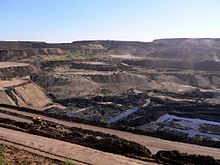

Coal is mined commercially in over 50 countries. 7,921 Mt of coal were produced in 2019, a 70% increase over the 20 years since 1999. In 2018, the world production of brown coal (lignite) was 803.2 Mt, with Germany the world's largest producer at 166.3 Mt. China is most likely the second largest producer and consumer of lignite globally although specific lignite production data is not made available.[1][12]
Coal production has grown fastest in Asia, while Europe has declined. Since 2011, world coal production has been stable, with decreases in Europe and USA offset by increases from China, Indonesia and Australia.[13] The top coal mining nations are:
| Country | Production[14] |
|---|---|
| China | 3,692 Mt |
| India | 745 Mt |
| United States | 640 Mt |
| Indonesia | 585 Mt |
| Australia | 500 Mt |
| Russia | 425 Mt |
| South Africa | 264 Mt |
| Germany | 132 Mt |
| Kazakhstan | 117 Mt |
| Poland | 112 Mt |
Most coal production is used in the country of origin, with around 16 percent of hard coal production being exported.[citation needed]
Economic impact[]
Globally coal mining is highly concentrated in certain jurisdictions, concentrating much of the social and economic impacts of the industry.[15] Globally the industry directly employs over 7 million workers, which creates millions of indirect jobs.[15] In many parts of the world, producers have reached peak coal as the global economy shifts away from fossil fuels like coal to address climate change. A 2020 study found that renewables jobs could feasibly be created in these geographies to replace many of the coal mining jobs as part of a just transition; however, renewable energy was not suitable in some of the geographies with high concentrations of miners (such as in China).[15]
| 2018 coal production, reserves, miners, and major coal-producing regions for China, India, The US, and Australia. Together, these countries account for 70% of global annual coal production. This table includes jurisdictions which are the top coal-producing provinces/states, responsible for over 85% of each country's coal production.[16] | |||||
| Country | Coal production (million tonnes) | Coal reserves (million tonnes) | Coal miners (thousands) | Top producing provinces or states | % of national production covered |
| China | 3349 | 138 819 | 6110 | Shanxi, Inner Mongolia, Shaanxi, Anhui, Heilongjiang, Xinjiang, Shandong, Henan, Guizhou | 90% |
| India | 717 | 97 728 | 485 | Chhattisgarh, Jharkhand, Orissa, Madhya Pradesh, Telangana | 85% |
| United States | 701 | 250 916 | 52 | Wyoming, , , Illinois, Kentucky, Texas, , Indiana, North Dakota | 90% |
| Australia | 478 | 144 818 | 50 | New South Wales, Queensland, Victoria | 99% |
Waste and refuse[]

Coal refuse (also described as coal waste, coal tailings, waste material, culm, boney, or gob[17]) is the material left over from coal mining, usually as tailings piles or spoil tips. For every tonne of hard coal generated by mining, 400 kilograms of waste material remains, which includes some lost coal that is partially economically recoverable.[18] Coal refuse is distinct from the byproducts of burning coal, such as fly ash.

Disasters[]
Modern mining[]

Technological advancements have made coal mining today more productive than it has ever been. To keep up with technology and to extract coal as efficiently as possible modern mining personnel must be highly skilled and well trained in the use of complex, state-of-the-art instruments and equipment. Many jobs require four-year university degrees. Computer knowledge has also become greatly valued within the industry as most of the machines and safety monitors are computerized.[citation needed]
The use of sophisticated sensing equipment to monitor air quality is common and has replaced the use of small animals such as canaries, often referred to as "miner's canaries".[23]
In the United States, the increase in technology has significantly decreased the mining workforce. in 2015 US coal mines had 65,971 employees, the lowest figure since EIA began collecting data in 1978.[24] However, a 2016 study reported that a relatively minor investment would allow most coal workers to retrain for the solar energy industry.[25]
Safety[]
Dangers to miners[]

Historically, coal mining has been a very dangerous activity and the list of historical coal mining disasters is a long one. In the US alone, more than 100,000 coal miners were killed in accidents in the twentieth century,[26] 90 percent of the fatalities occurring in the first half of the century.[27] More than 3,200 died in 1907 alone.[28]
Open cut hazards are principally mine wall failures and vehicle collisions; underground mining hazards include suffocation, gas poisoning, roof collapse, rock burst, outbursts, and gas explosions.[citation needed]
Firedamp explosions can trigger the much-more-dangerous coal dust explosions, which can engulf an entire pit. Most of these risks can be greatly reduced in modern mines, and multiple fatality incidents are now rare in some parts of the developed world. Modern mining in the US results in approximately 30 deaths per year due to mine accidents.[29] However, in lesser developed countries and some developing countries, many miners continue to die annually, either through direct accidents in coal mines or through adverse health consequences from working under poor conditions. China, in particular, has the highest number of coal mining related deaths in the world, with official statistics claiming that 6,027 deaths occurred in 2004.[30] To compare, 28 deaths were reported in the US in the same year.[31] Coal production in China is twice that in the US,[32] while the number of coal miners is around 50 times that of the US, making deaths in coal mines in China 4 times as common per worker (108 times as common per unit output) as in the US.[citation needed]
Mine disasters have still occurred in recent years in the US,[33] Examples include the Sago Mine disaster of 2006, and the 2007 mine accident in Utah's Crandall Canyon Mine, where nine miners were killed and six entombed.[34] In the decade 2005–2014, US coal mining fatalities averaged 28 per year.[35] The most fatalities during the 2005–2014 decade were 48 in 2010, the year of the Upper Big Branch Mine disaster in West Virginia, which killed 29 miners.[36]
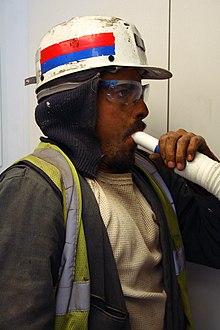
Chronic lung diseases, such as pneumoconiosis (black lung) were once common in miners, leading to reduced life expectancy. In some mining countries black lung is still common, with 4,000 new cases of black lung every year in the US (4 percent of workers annually) and 10,000 new cases every year in China (0.2 percent of workers).[37] The use of water sprays in mining equipment reduces the risk to miners' lungs.[38] Build-ups of a hazardous gas are known as damps, possibly from the German word "Dampf" which means steam or vapor:
- Black damp: a mixture of carbon dioxide and nitrogen in a mine can cause suffocation, and is formed as a result of corrosion in enclosed spaces so removing oxygen from the atmosphere.[39]
- After damp: similar to black damp, after damp consists of carbon monoxide, carbon dioxide and nitrogen and forms after a mine explosion.
- Fire damp: consists of mostly methane, a highly flammable gas that explodes between 5% and 15% – at 25% it causes asphyxiation.
- Stink damp: so named for the rotten egg smell of the hydrogen sulfide gas, stink damp can explode and is also very toxic.
- White damp: air containing carbon monoxide which is toxic, even at low concentrations
- A heavy curtain used to direct air currents in mines and prevent the buildup of dangerous gases is known as a damp sheet.
Noise is also a contributing factor to potential adverse effects on coal miners' health. Exposure to excessive noise can lead to noise-induced hearing loss. Hearing loss developed as a result of occupational exposures is coined occupational hearing loss. To protect miners' hearing, the US Mine Safety and Health Administration's (MSHA) guidelines for noise place a Permissible Exposure Limit (PEL) for noise at 90 dBA time-weighted over 8 hours. A lower cutoff, 85 dBA, is set for a worker to fall into the MSHA Action Level which dictates that workers be placed into hearing conservation programs.[citation needed]
Noise exposures vary depending on the method of extraction. For example, a study has found that among surface coal mine operations, dragline equipment produced the loudest sound at a range of 88–112 dBA.[40] Within longwall sections, stageloaders used to transport coal from the mining face and shearers used for extraction represent some of the highest noise exposures. Auxiliary fans (up to 120 dBA), continuous mining machines (up to 109 dBA), and roof bolters (up to 103 dBA) represent some of the noisiest equipment within continuous mining sections.[41] Exposures to noise exceeding 90 dBA can lead to adverse effects on workers' hearing. The use of administrative controls and engineering controls can be used to reduce noise exposures.[citation needed]
Safety improvements[]
Improvements in mining methods (e.g. longwall mining), hazardous gas monitoring (such as safety-lamps or more modern electronic gas monitors), gas drainage, electrical equipment, and ventilation have reduced many of the risks of rock falls, explosions, and unhealthy air quality. Gases released during the mining process can be recovered to generate electricity and improve worker safety with gas engines.[42] Another innovation in recent years is the use of closed circuit escape respirators, respirators that contain oxygen for situations where mine ventilation is compromised.[43] Statistical analyses performed by the US Department of Labor's Mine Safety and Health Administration (MSHA) show that between 1990 and 2004, the industry cut the rate of injuries by more than half and fatalities by two-thirds. However, according to the Bureau of Labor Statistics, even in 2006, mining remained the second most dangerous occupation in America, when measured by fatality rate.[44][verification needed] However, these numbers include all mining, with oil and gas mining contributing the majority of fatalities; coal mining resulted in only 47 fatalities that year.[44]
Health and environmental impacts[]

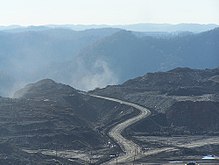
The health and environmental impact of the coal industry includes issues such as land use, waste management, water and air pollution, caused by the coal mining, processing and the use of its products. In addition to atmospheric pollution, coal burning produces hundreds of millions of tons of solid waste products annually, including fly ash,[45] bottom ash, and flue-gas desulfurization sludge, that contain mercury, uranium, thorium, arsenic, and other heavy metals. Coal is the largest contributor to the human-made increase of carbon dioxide in Earth's atmosphere.
There are severe health effects caused by burning coal.[46][47] According to a report by the World Health Organization in 2008, coal particulates pollution are estimated to shorten approximately 10,000 lives annually worldwide.[48] A 2004 study commissioned by environmental groups, but contested by the United States Environmental Protection Agency, concluded that coal burning costs 24,000 lives a year in the United States.[49] More recently, an academic study estimated that the premature deaths from coal related air pollution was about 52,000.[50] When compared to electricity produced from natural gas via hydraulic fracturing, coal electricity is 10–100 times more toxic, largely due to the amount of particulate matter emitted during combustion.[51] When coal is compared to solar photovoltaic generation, the latter could save 51,999 American lives per year if solar were to replace coal-based energy generation in the U.S.[52][53] Due to the decline of jobs related to coal mining a study found that approximately one American suffers a premature death from coal pollution for every job remaining in coal mining.[54]
In addition, the list of historical coal mining disasters is a long one, although work related coal deaths has declined substantially as safety measures have been enacted and underground mining has given up market share to surface mining. Underground mining hazards include suffocation, gas poisoning, roof collapse and gas explosions. Open cut hazards are principally mine wall failures and vehicle collisions. In the United States, an average of 26 coal miners per year died in the decade 2005–2014.[55]Coal mining by country[]
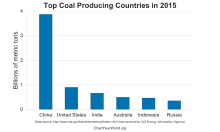
Top 10 hard and brown coal producers in 2012 were (in million metric tons): China 3,621, United States 922, India 629, Australia 432, Indonesia 410, Russia 351, South Africa 261, Germany 196, Poland 144, and Kazakhstan 122.[56][57]
Australia[]

Coal has been mined in every state of Australia, but mainly in Queensland, New South Wales and Victoria. It is mostly used to generate electricity, and 75% of annual coal production is exported, mostly to eastern Asia.
In 2007, 428 million tonnes of coal was mined in Australia.[58] In 2007, coal provided about 85% of Australia's electricity production.[59] In the fiscal year 2008/09, 487 million tonnes of coal was mined, and 261 million tonnes was exported.[60] In the fiscal year 2013/14, 430.9 million tonnes of coal was mined, and 375.1 million tonnes was exported.[61] In 2013/14, coal provided about 69% of Australia's electricity production.[62]
In 2013, Australia was the world's fifth-largest coal producer, after China, the United States, India, and Indonesia. However, in terms of proportion of production exported, Australia is the world's second largest coal exporter, as it exports roughly 73% of its coal production. Indonesia exports about 87% of its coal production.[62]
A court in Australia has cited climate change in ruling against a new coal mine.[63]
Canada[]
Canada was ranked as the 15th coal producing country in the world in 2010, with a total production of 67.9 million tonnes. Canada's coal reserves, the 12th largest in the world, are located largely in the province of Alberta.[64]
The first coal mines in North America were located in Joggins and Port Morien, Nova Scotia, mined by French settlers beginning in the late 1600s. The coal was used for the British garrison at Annapolis Royal, and in the construction of the Fortress of Louisbourg.[citation needed]
Chile[]
Compared to other South American countries Chile has limited coal resources. Only Argentina is similarly poor.[65] Coal in Chile is mostly sub-bituminous with the exception of the bituminous coals of the Arauco Basin in central Chile.[66]
China[]
The China is by far the largest producer of coal in the world, producing over 2.8 billion tons of coal in 2007, or approximately 39.8 percent of all coal produced in the world during that year.[58] For comparison, the second largest producer, the United States, produced more than 1.1 billion tons in 2007. An estimated 5 million people work in China's coal-mining industry. As many as 20,000 miners die in accidents each year.[67] Most Chinese mines are deep underground and do not produce the surface disruption typical of strip mines. Although there is some evidence of reclamation of mined land for use as parks, China does not require extensive reclamation and is creating significant acreages of abandoned mined land, which is unsuitable for agriculture or other human uses, and inhospitable to indigenous wildlife. Chinese underground mines often experience severe surface subsidence (6–12 meters), negatively impacting farmland because it no longer drains well. China uses some subsidence areas for aquaculture ponds but has more than they need for that purpose. Reclamation of subsided ground is a significant problem in China. Because most Chinese coal is for domestic consumption, and is burned with little or no air pollution control equipment, it contributes greatly to visible smoke and severe air pollution in industrial areas using coal for fuel. China's total energy uses 67% from coal mines.[citation needed]
Colombia[]
Some of the world's largest coal reserves are located in South America, and an opencast mine at Cerrejón in Colombia is one of the world's largest open pit mines. The output of the mine in 2004 was 24.9 million tons (compared to total global hard coal production of 4,600 million tons). Cerrejón contributed about half of Colombia's coal exports of 52 million tons that year, with Colombia ranked sixth among major coal exporting nations. The company planned to expand production to 32 million tons by 2008. The company has its own 150 km standard-gauge railroad, connecting the mine to its coal-loading terminal at Puerto Bolívar on the Caribbean coast. There are two 120-car unit trains, each carrying 12,000 tons of coal per trip. The round-trip time for each train, including loading and unloading, is about 12 hours. The coal facilities at the port are capable of loading 4,800 tons per hour onto vessels of up to 175,000 tons of dead weight. The mine, railroad and port operate 24 hours per day. Cerrejón directly employs 4,600 workers, with a further 3,800 employed by contractors. The reserves at Cerrejón are low-sulfur, low-ash, bituminous coal. The coal is mostly used for electric power generation, with some also used in steel manufacture. The surface mineable reserves for the current contract are 330 million tons. However, total proven reserves to a depth of 300 metres are 3,000 million tons.[citation needed]
The expansion of the Cerrejón mine has been blamed for the forced displacement of local communities.[68][69]
Germany[]
Germany has a long history of coal mining, going back to the Middle Ages. Coal mining greatly increased during the industrial revolution and the following decades. The main mining areas were around Aachen, the Ruhr and Saar area, along with many smaller areas in other parts of Germany. These areas grew and were shaped by coal mining and coal processing, and this is still visible even after the end of the coal mining.[citation needed]
Coal mining reached its peak in the first half of the 20th century. After 1950, the coal producers started to struggle financially. In 1975, a subsidy was introduced (Kohlepfennig). In 2007, the Bundestag decided to end subsidies by 2018. As a consequence, RAG AG, the owner of the two remaining coal mines in Germany, announced it would close all mines by 2018, thus ending coal mining in Germany.[citation needed]
Greece[]
Lignite has been mined in Greece since 1873, and today supplies approximately 75% of the country's energy. The main mining areas are located in Western Macedonia (Ptolemaida) and the Pelopponese (Megalopolis).[70]
India[]

Coal mining in India has a long history of commercial exploitation starting in 1774 with John Sumner and Suetonius Grant Heatly of the East India Company in the Raniganj Coalfield along the Western bank of Damodar River. Demand for coal remained low until the introduction of steam locomotives in 1853. After this, production rose to an annual average of 1 Mt and India produced 6.12 Mt per year by 1900 and 18 Mt per year by 1920, following increased demand in the First World War, but went through a slump in the early thirties. The production reached a level of 29 Mt by 1942 and 30 Mt by 1946. After independence, the country embarked upon five-year development plans. At the beginning of the 1st Plan, annual production went up to 33 Mt. During the 1st Plan period, the need for increasing coal production efficiently by systematic and scientific development of the coal industry was being felt. Setting up the National Coal Development Corporation (NCDC), a Government of India undertaking, in 1956 with the collieries owned by the railways as its nucleus was the first major step towards planned development of Indian Coal Industry. Along with the Singareni Collieries Company Ltd. (SCCL) which was already in operation since 1945 and which became a government company under the control of Government of Andhra Pradesh in 1956, India thus had two Government coal companies in the fifties. SCCL is now a joint undertaking of Government of Telangana and Government of India.[citation needed]
Japan[]

The richest Japanese coal deposits have been found on Hokkaido and Kyushu.
Japan has a long history of coal mining dating back into the Japanese Middle Ages. It is said that coal was first discovered in 1469 by a farming couple near Ōmuta, central Kyushu.[71] In 1478, farmers discovered burning stones in the north of the island, which led to the exploitation of the Chikuhõ coalfield.[72]
Following Japanese industrialization additional coalfields were discovered northern Japan. One of the first mines in Hokkaido was the Hokutan Horonai coal mine.[73]
Poland[]
This article needs to be updated. (May 2020) |
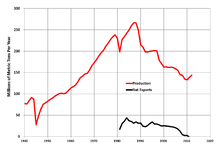
Coal mining in Poland produced 144 million metric tons of coal in 2012, providing 55 percent of that country’s primary energy consumption, and 75 percent of electrical generation. Poland is the second-largest coal-mining country in Europe, after Germany, and the ninth-largest coal producer in the world. The country consumes nearly all the coal it mines, and is no longer a major coal exporter.[74]
Coal mines are concentrated mainly in Upper Silesia. The most profitable mines were Marcel Coal Mine and Zofiówka Coal Mine. In communist times (1945-1989) one of the most important and largest mines was 1 Maja Coal Mine.
As of 2020, coal powered 74% of Poland’s electricity generation. However extraction is becoming increasingly difficult and expensive, and has become uncompetitive against Russian imports. The industry now relies on government subsidies, taking nearly all of the annual €1.6 billion government energy sector support. In September 2020, the government and mining union agreed a plan to phase out coal by 2049.[75]Russia[]
Russia ranked as the fifth largest coal producing country in 2010, with a total production of 316.9 Mt. Russia has the world's second largest coal reserves.[76] Russia and Norway share the coal resources of the Arctic archipelago of Svalbard, under the Svalbard Treaty.[citation needed]
Spain[]
Spain was ranked as the 30th coal producing country in the world in 2010. The coal miners of Spain were active in the Spanish Civil War on the Republican side. In October 1934, in Asturias, union miners and others suffered a fifteen-day siege in Oviedo and Gijon. There is a museum dedicated to coal mining in the region of Catalonia, called Cercs Mine Museum.[citation needed]
In October 2018, the Sánchez government and Spanish Labour unions settled an agreement to close ten Spanish coal mines at the end of 2018. The government pre-engaged to spend 250 million Euro to pay for early retirements, occupational retraining and structural change. In 2018, about 2,3 per cent of the electric energy produced in Spain was produced in coal-burning power plants.[77]
South Africa[]
South Africa is one of the ten largest coal producing countries[78][79] and the fourth largest coal exporting country[80] in the world.
Taiwan[]

In Taiwan, coal is distributed mainly in the northern area. All of the commercial coal deposits occurred in three Miocene coal-bearing formations, which are the Upper, the Middle and the Lower Coal Measures. The Middle Coal Measures was the most important with its wide distribution, great number of coal beds and extensive potential reserves. Taiwan has coal reserves estimated to be 100–180 Mt. However, coal output had been small, amounting to 6,948 metric tonnes per month from 4 pits before it ceased production effectively in 2000.[81] The abandoned coal mine in Pingxi District, New Taipei has now turned into the Taiwan Coal Mine Museum.[82]
Turkey[]
Ukraine[]
In 2012 coal production in Ukraine amounted to 85.946 million tonnes, up 4.8% from 2011.[94] Coal consumption that same year grew to 61.207 million tonnes, up 6.2% compared with 2011.[94]
More than 90 percent of Ukraine's coal production comes from the Donets Basin.[95] The country's coal industry employs about 500,000 people.[96] Ukrainian coal mines are among the most dangerous in the world, and accidents are common.[97] Furthermore, the country is plagued with extremely dangerous illegal mines.[98]
United Kingdom[]
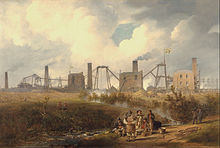

Coal mining in the United Kingdom dates back to Roman times and occurred in many different parts of the country. Britain's coalfields are associated with Northumberland and Durham, North and South Wales, Yorkshire, the Scottish Central Belt, Lancashire, Cumbria, the East and West Midlands and Kent. After 1972, coal mining quickly collapsed and had practically disappeared by the 21st century.[99] The consumption of coal – mostly for electricity – fell from 157 million tonnes in 1970 to 18 million tonnes in 2016, of which 77% (14 million tonnes) was imported from Colombia, Russia, and the United States.[100] Employment in coal mines fell from a peak of 1,191,000 in 1920 to 695,000 in 1956, 247,000 in 1976, 44,000 in 1993, and to 2,000 in 2015.[101]
Almost all onshore coal resources in the UK occur in rocks of the Carboniferous age, some of which extend under the North Sea. Bituminous coal is present in most of Britain's coalfields and is 86% to 88% carbon. In Northern Ireland, there are extensive deposits of lignite which is less energy-dense based on oxidation (combustion) at ordinary combustion temperatures (i.e. for the oxidation of carbon – see fossil fuels).[102]
The last deep coal mine in the UK closed on 18 December 2015. Twenty-six open cast mines still remained in operation at the end of 2015.[103] said in 2018 they planned to start mining a new site in County Durham[104] but in 2020 closed a major open cast site, Bradley mine, near Dipton in the county[105] and the last open cast site then operating in England, Hartington at Staveley, Derbyshire, was expected to close by the end of that year.[106] In 2020 Whitehaven coal mine became the first approved new deep coal mine in the United Kingdom in 30 years.[107]United States[]
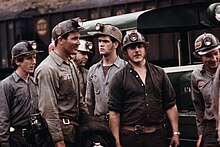
Coal was mined in America in the early 18th century, and commercial mining started around 1730 in Midlothian, Virginia.[108]
The American share of world coal production remained steady at about 20 percent from 1980 to 2005, at about 1 billion short tons per year. The United States was ranked as the second highest coal producing country in the world in 2010, and possesses the largest coal reserves in the world. In 2008 then-President George W. Bush stated that coal was the most reliable source of electricity.[109] However, in 2011 President Barack Obama said that the US should rely more on cleaner sources of energy that emit lower or no carbon dioxide pollution.[110] For a time, while domestic coal consumption for electric power was being displaced by natural gas, exports were increasing.[111] US net coal exports increased ninefold from 2006 to 2012, peaked at 117 million short tons in 2012, then declined to 63 million tons in 2015. In 2015, 60% of net US exports went to Europe, 27% to Asia.US coal production increasingly comes from strip mines in the western United States, such as from the Powder River Basin in Wyoming and Montana.[112]
Coal has come under continued price pressure from natural gas and renewable energy sources, which has resulted in a rapid decline of coal in the U.S. and several notable bankruptcies including Peabody Energy. On 13 April 2016 it reported, that its revenue had reduced by 17 percent as coal prices fell and that it had lost two billion dollars the previous year.[113] It then filed Chapter 11 bankruptcy on 13 April 2016.[113] The Harvard Business Review discussed retraining coal workers for solar photovoltaic employment because of the rapid rise in U.S. solar jobs.[114] A 2016 study indicated that this was technically possible and would account for only 5% of the industrial revenue from a single year to provide coal workers with job security in the energy industry as whole.[25]
Donald Trump pledged to bring back coal jobs during the 2016 US presidential election, and as president he announced plans to reduce environmental protection, particularly by repealing the Clean Power Plan (CPP). However, industry observers have warned that this might not lead to a boom in mining jobs[115] A 2019 projection by the Energy Information Administration estimated that coal production without CPP would decline over coming decades at a faster rate than indicated in the agency's 2017 projection, which had assumed the CPP was in effect.[116]
See also[]
- Black lung disease
- George Bretz (photographer)
- Child labour
- Coal Measures
- Coal slurry impoundment
- Coal train
- Coal-mining region
- Environmental impact of the coal industry
- Environmental justice and coal mining in Appalachia
References[]
- ^ Jump up to: a b "Coal Information: Overview". Paris: International Energy Agency. July 2020. Retrieved 4 November 2020.
- ^ Jump up to: a b Barbara Freese (2004). Coal: A Human History. Penguin Books. pp. 137. ISBN 9780142000984.(stating that, "[c]oal consumption doubled every decade between 1850 and 1890" and that by turn of the century, "coal was the unrivaled foundation of U.S. Power," providing "71 percent of the nation's energy."
- ^ James G. Speight (2011). An Introduction to Petroleum Technology, Economics, and Politics. John Wiley & Sons. pp. 260–61. ISBN 9781118192542.
- ^ Geoff Eley, Forging Democracy: The History of the Left in Europe, 1850-2000 (2002); Frederic Meyers, European Coal Mining Unions: structure and function (1961) P. 86; Kazuo and Gordon (1997) p 48; Hajo Holborn, History of Modern Germany (1959) p. 521; David Frank, J. B. McLachlan: A Biography: The Story of a Legendary Labour Leader and the Cape Breton Coal Miners, (1999) p, 69; David Montgomery, The fall of the house of labor: the workplace, the state, and American labor activism, 1865-1925 (1991) p 343.
- ^ Reyes Herrera, Sonia E.; Rodríguez Torrent, Juan Carlos; Medina Hernández, Patricio (2014). "El sufrimiento colectivo de una ciudad minera en declinación. El caso de Lota, Chile". Horizontes Antropológicos (in Spanish). 20 (42).
- ^ "Methods of Coal Mining" Archived 18 March 2012 at the Wayback Machine Great Mining (2003) accessed 19 December 2011
- ^ Jump up to: a b Christman, R.C., J. Haslbeck, B. Sedlik, W. Murray, and W. Wilson. 1980. Activities, effects and impacts of the coal fuel cycle for a 1,000-MWe electric power generating plant. Washington, DC: U.S. Nuclear Regulatory Commission.
- ^ Jump up to: a b c d e "Coal Mining. World Coal". World Coal Institute. 10 March 2009. Archived from > the original on 28 April 2009.
- ^ Jump up to: a b U.S. Department of the Interior, Office of Surface Mining Reclamation and Enforcement (1987). Surface coal mining reclamation: 10 years of progress, 1977–1987. Washington, D.C.: U.S. Government Printing Office.
- ^ "Mountain Justice Summer – What is Mountain Top Removal Mining?". 29 October 2005. Archived from the original on 29 October 2005.
- ^ U.S. Environmental Protection Agency, Philadelphia, PA (2005). "Mountaintop mining/valley fills in Appalachia: Final programmatic environmental impact statement."
- ^ "Coal Information: Overview" (PDF). Paris: International Energy Agency. 2019. Retrieved 4 November 2020.
- ^ "Coal production | Coal | Statistical Review of World Energy | Energy economics | BP". bp.com. Retrieved 10 November 2017.
- ^ "Coal and lignite production". Global Energy Statistical Yearbook. Grenoble, France: Enerdata. 2020. Retrieved 4 November 2020.
- ^ Jump up to: a b c Table is extracted from Pai, Sandeep; Zerriffi, Hisham; Jewell, Jessica; Pathak, Jaivik (6 March 2020). "Solar has greater techno-economic resource suitability than wind for replacing coal mining jobs". Environmental Research Letters. 15 (3): 034065. doi:10.1088/1748-9326/ab6c6d. ISSN 1748-9326.
- ^ Ivanova, Diana; Barrett, John; Wiedenhofer, Dominik; Macura, Biljana; Callaghan, Max W; Creutzig, Felix (1 April 2020). "Quantifying the potential for climate change mitigation of consumption options". Environmental Research Letters. 15 (9): 093001. doi:10.1088/1748-9326/ab8589. ISSN 1748-9326.
- ^ "Waste Coal | Energy Justice Network". www.energyjustice.net. Retrieved 2 August 2020.
- ^ Fecko, P.; Tora, B.; Tod, M. (1 January 2013), Osborne, Dave (ed.), "3 - Coal waste: handling, pollution impacts and utilization", The Coal Handbook: Towards Cleaner Production, Woodhead Publishing Series in Energy, Woodhead Publishing, 2, pp. 63–84, ISBN 978-1-78242-116-0, retrieved 2 August 2020
- ^ "Waste Coal | Energy Justice Network". www.energyjustice.net. Retrieved 2 August 2020.
- ^ Kowalska, Arlena, et al., "VLF mapping and resistivity imaging of contaminated quaternary formations near to 'Panewniki' coal waste disposal (Southern Poland)." Acta Geodynamica et Geromaterialia, vol. 9, no. 4, 2012, p. 473+. Gale Academic OneFile, https://link-gale-com.wikipedialibrary.idm.oclc.org/apps/doc/A311377866/GPS?u=wikipedia&sid=GPS&xid=f0f488c8. Accessed 7 Aug. 2020.
- ^ POWER (1 July 2016). "The Coal Refuse Dilemma: Burning Coal for Environmental Benefits". POWER Magazine. Retrieved 2 August 2020.
- ^ Dove, D.; Daniels, W.; Parrish, D. (1990). "Importance of Indigenous VAM Fungi for the Reclamation of Coal Refuse Piles". Journal American Society of Mining and Reclamation. 1990 (1): 463–468. doi:10.21000/jasmr90010463. ISSN 2328-8744.
- ^ Engelbert, Phillis. "Energy – What Is A "Miner's Canary"?". enotes. Archived from the original on 1 October 2011. Retrieved 18 August 2010.
- ^ "Annual Coal Report – Energy Information Administration". www.eia.gov.
- ^ Jump up to: a b Louie, Edward P.; Pearce, Joshua M. (June 2016). "Retraining investment for U.S. transition from coal to solar photovoltaic employment" (PDF). Energy Economics. 57: 295–302. doi:10.1016/j.eneco.2016.05.016.
- ^ "Former Miner Explains Culture Of Mining." NPR: National Public Radio. 7 April 2010.
- ^ Coal Mining Fatalities 1900–2014 Archived 3 October 2015 at the Wayback Machine, US Dept. of the Interior, MSHA.
- ^ "Coal Mining Steeped in History". ABC News. 5 January 2006.
- ^ OccupationalHazards.com. "Respiratory Protection in Coal Mines." Archived 23 April 2008 at the Wayback Machine
- ^ "CLB :: Deconstructing deadly details from China's coal mine safety statistics". 30 September 2007. Archived from the original on 30 September 2007.
- ^ US Mine Safety and Health Administration. "Statistics – Coal Mining Fatalities by State – Calendar Year." Archived 23 February 2011 at the Wayback Machine
- ^ "Home". World Coal Association.
- ^ "Census of Fatal Occupational Injuries Summary, 2006 Washington D.C.: U.S. Department of Labor". Bureau of Labor Statistics. (2006).
- ^ "Panel to Explore Deadly Mine Accident". The New York Times. Associated Press. 4 September 2007.
- ^ Coal mining fatalities Archived 19 April 2016 at the Wayback Machine, US Mine Safety and Health Administration, accessed 27 June 2016.
- ^ Urbina, Ian (9 April 2010). "No Survivors Found After West Virginia Mine Disaster". The New York Times.
- ^ Abelard.org, "Fossil fuel disasters".
- ^ Jacquelyn L. Banasik (2018). Pathophysiology. Elsevier Health Sciences. p. 504. ISBN 9780323510424.
- ^ Notes of an Enquiry into the Nature and Physiological Action of Black-Damp, as Met with in Podmore Colliery, Staffordshire, and Lilleshall Colliery, Shropshire, John Haldane, Proceedings of the Royal Society of London, Vol. 57, 1894 - 1895 (1894 - 1895), pp. 249-257
- ^ Bauer, ER (April 2004). "Worker exposure and equipment noise in large surface coal mines". Min Eng. 56: 49–54.
- ^ "Summary of Longwall and Continuous Miner Section Noise Studies in Underground Coal Mines". www.cdc.gov. Retrieved 15 August 2018.
- ^ Coal Gas Utilisation, www.clarke-energy.com
- ^ Krah, Jaclyn; Unger, Richard L. (7 August 2013). "The Importance of Occupational Safety and Health: Making for a "Super" Workplace". National Institute for Occupational Safety and Health. Retrieved 15 January 2015.
- ^ Jump up to: a b U.S. Bureau of Labor Statistics. Stats.bls.gov
- ^ RadTown USA | US EPA
- ^ Toxic Air: The Case for Cleaning Up Coal-fired Power Plants (PDF) (Report). American Lung Association. March 2011. Archived from the original (PDF) on 15 May 2012. Retrieved 9 March 2012.
- ^ "Environmental impacts of coal power: air pollution". Union of Concerned Scientists. Retrieved 9 March 2012.
- ^ Deaths per TWH by Energy Source Archived 24 July 2015 at the Wayback Machine, Next Big Future, March 2011. Quote: "The World Health Organization and other sources attribute about 1 million deaths/year to coal air pollution."
- ^ "Deadly Power Plants? Study Fuels Debate". NBC News. 9 June 2004. Retrieved 6 March 2012.
- ^ Caiazzo, F., Ashok, A., Waitz, I.A., Yim, S.H. and Barrett, S.R., 2013. Air pollution and early deaths in the United States. Part I: Quantifying the impact of major sectors in 2005. Atmospheric Environment, 79, pp.198–208.
- ^ Chen, Lu; Miller, Shelie A.; Ellis, Brian R. (2017). "Comparative Human Toxicity Impact of Electricity Produced from Shale Gas and Coal". Environmental Science & Technology. 51 (21): 13018–13027. Bibcode:2017EnST...5113018C. doi:10.1021/acs.est.7b03546. PMID 29016130.
- ^ USA Today. The US could prevent a lot of deaths by switching from coal to solar https://www.usatoday.com/videos/money/2017/06/01/-us-could-prevent-lot-deaths-switching-coal-solar/102405132/
- ^ Prehoda, Emily W.; Pearce, Joshua M. (2017), "Potential lives saved by replacing coal with solar photovoltaic electricity production in the U.S" (PDF), Renewable and Sustainable Energy Reviews, 80: 710–715, doi:10.1016/j.rser.2017.05.119
- ^ "These Two Industries Kill More People Than They Employ". IFLScience. Retrieved 9 March 2019.
- ^ "Coal Fatalities for 1900 Through 2016". Arlington, VA: U.S. Mine Safety and Health Administration (MSHA). Archived from the original on 3 October 2015. Retrieved 25 October 2017.
- ^ IEA Key energy statistics 2010 pages 11, 21
- ^ US Energy Information Administration, International energy statistics, accessed 29 December 2013.
- ^ Jump up to: a b "World Coal Production, Most Recent Estimates 1980–2007 (October 2008)". U.S. Energy Information Administration. 2008.
- ^ "The Importance of Coal in the Modern World – Australia". Gladstone Centre for Clean Coal. Archived from the original on 8 February 2007. Retrieved 17 March 2007.
- ^ "Australia Mineral Statistics 2009 – June Quarter" (PDF). Australian Bureau of Agricultural and Resource Economics. Archived from the original (PDF) on 7 July 2011. Retrieved 3 October 2009.
- ^ "September 2015 – Resources and Energy Quarterly" (PDF). Australia Office of the Chief Economist. September 2015. pp. 44, 56. Archived from the original (PDF) on 17 November 2015. Retrieved 3 October 2015.
- ^ Jump up to: a b WCA (September 2014). "Coal Statistics". Today in Energy. World Coal Association. Retrieved 3 May 2015.
- ^ "Court rules out Hunter Valley coalmine on climate change grounds". The Guardian. 7 February 2019.
- ^ "Overview of Canada's Coal Sector" (PDF). Natural Resources Canada. Archived from the original (PDF) on 25 May 2013. Retrieved 6 March 2012.
- ^ Hernán Scandizzo (31 December 2016). "Carbón 2.0, otro capítulo de la saga no convencional" [Coal 2.0, another chapter of the non-conventional energy saga] (in Spanish). Rebelion.org. Retrieved 16 January 2017.
- ^ Davis, Eliodoro Martín (1990). "Breves recuerdos de algunas actividades mineras del carbón". Actas. Segundo Simposio sobre el Terciario de Chile (in Spanish). Santiago, Chile: Departamento de Geociencias, Facultad de Ciencias, Universidad de Concepción. pp. 189–203.
- ^ "Where The Coal Is Stained With Blood." Time, 2 March 2007.
- ^ "DIGGING DEEPER: THE HUMAN RIGHTS IMPACTS OF COAL IN THE GLOBAL SOUTH" (PDF).
- ^ "Carbones del Cerrejón y Responsabilidad Social: Una revisión independiente de los impactos y del objetivo" (PDF). Archived from the original (PDF) on 15 March 2017.
- ^ https://www.miningreece.com/mining-greece/minerals/coal/
- ^ Kodama Kiyoomi, Sekitan no gijutsushi, p. 19
- ^ Honda Tatsumi, Honda Tatsumi shashinshũ tankō ōsai, p. 165
- ^ Kasuga Yutaka, Transfer and Development of Coal-Mine Technology in Hokkaido, pp. 11–20.
- ^ US Energy Information Administration Poland overview, Sept 2013
- ^ Gatten, Emma; Suszko, Agnieszka (22 October 2020). "Can Poland, the dirty man of Europe, end its love affair with coal?". The Daily Telegraph. Retrieved 23 October 2020.
- ^ "BP Statistical review of world energy June 2007". BP. June 2007. Archived from the original (XLS) on 6 February 2009. Retrieved 22 October 2007.
- ^ theguardian.com 26. October 2018: Spain to close most coal mines after striking €250m deal
- ^ Schmidt, Stephan. "Coal deposits of South Africa – the future of coal mining in South Africa" (PDF). Institute for Geology, Technische Universität Bergakademie Freiberg. Retrieved 14 January 2010.
- ^ "Coal Mining". World Coal Institute. Retrieved 14 January 2010.
- ^ "Coal". Department of Minerals and Energy (South Africa). Archived from the original on 2 December 2009. Retrieved 14 January 2010.
- ^ "Bureau of Energy, Ministry of Economic Affairs, R.O.C. – Energy Statistical annual Reports". Web3.moeaboe.gov.tw. Retrieved 21 September 2018.
- ^ "Coal Mining in Taiwan (ROC) – Overview". Mbendi.com. Archived from the original on 17 October 2015. Retrieved 26 May 2014.
- ^ Jump up to: a b "Coal overview: Turkey" (PDF). Global Methane Project. 2020.
- ^ Collings, Ronald. "Pre-feasibility Study for Coal Mine Methane Drainage and Utilization at the Kozlu Coal Mine in Zonguldak, Turkey" (PDF).
- ^ "Turkey's 21st Century Coal Rush". Global Business Reports. Archived from the original on 17 May 2019. Retrieved 17 May 2019.
- ^ Ersoy (2019), p. 8.
- ^ Ersoy (2019), p. 3.
- ^ "Coal mine collapses in Turkey". Trend. 18 February 2019. Archived from the original on 1 March 2019. Retrieved 28 February 2019.
- ^ "Tender announcements". MAPEG. Archived from the original on 25 February 2019. Retrieved 24 February 2019.
- ^ Global Business Reports (2018), p. 37,38.
- ^ "30 bin kişi madencilik işlemlerini e-maden üzerinden sonuçlandırdı" [30 thousand people served by e-maden for mining procedures]. Hurriyet (in Turkish). 16 April 2021.
- ^ "2019 Country Reports on Human Rights Practices: Turkey". U.S. Embassy & Consulates in Turkey. 12 March 2020. Archived from the original on 12 April 2020. Retrieved 30 March 2020.
- ^ Eleventh Development Plan (2019-2023) (PDF) (Report). Presidency of Strategy and Budget. 2020.
- ^ Jump up to: a b Ukraine plans to reach extraction of 105 m t of coal a year, says president, Interfax-Ukraine (30 August 2013) Archived 4 April 2020 at the Wayback Machine
- ^ Ukraine – Mining: Coal Mining Archived 17 October 2015 at the Wayback Machine
- ^ Ukraine – Coal Archived 23 July 2009 at the Wayback Machine, eia.doe.gov
- ^ Ukraine mine blast leaves 16 dead, BBC News (29 July 2011)
- ^ Illegal mines profitable, but at massive cost to nation, Kyiv Post (8 July 2011)
- ^ Seddon, Mark (10 April 2013). "The long, slow death of the UK coal industry" (The Northerner blog). The Guardian. London. Retrieved 17 April 2013.
Earlier this month Maltby colliery in South Yorkshire closed down for good. At the end of a winter that saw 40% of our energy needs met by coal – most of it imported – we witnessed the poignant closing ceremony
- ^ "Digest of UK Energy Statistics (DUKES): solid fuels and derived gases". www.gov.uk. Retrieved 17 January 2018.
- ^ Department for Business, Energy & Industrial Strategy, "Historical coal data: coal production, availability and consumption 1853 to 2015" (2016)
- ^ "Mineral Profile - Coal". bgs.ac.uk. British Geological Society. March 2010. Retrieved 7 July 2015.
- ^ "Surface Coal Mining Statistics". www.bgs.ac.uk. 2014. Retrieved 7 July 2015.
- ^ "Banks Mining looking to operate Bradley surface mine in County Durham". www.banksgroup.co.uk. Banks Group. Retrieved 17 January 2018.
- ^ "Bradley mine: Coal extracted for final time at County Durham site". BBC News. 17 August 2020. Retrieved 17 August 2020.
- ^ Ambrose, Jillian (22 August 2020). "Journey's end: last of England's open-cast mines begins final push". The Guardian. London. Retrieved 28 August 2020.
- ^ Media, P. A. (6 January 2021). "Jenrick criticised over decision not to block new Cumbria coal mine". The Guardian. Retrieved 7 January 2021.
- ^ MCCartney, Martha W. (1989). "Historical Overview Of The Midlothian Coal Mining Company Tract, Chesterfield County, Virginia." Archived 19 April 2007 at the Wayback Machine December 1989.
- ^ The White House, Washington, DC (2008). "President Bush Attends 2008 Annual Meeting of the West Virginia Coal Association." President George W. Bush Archives. Press release, 31 July 2008.
- ^ Lomax, Simon (9 February 2011). "'Massive' Closures of U.S. Coal Plants Loom, Chu Says". Bloomberg Business Week.
- ^ "Quarterly Coal Report – Energy Information Administration". www.eia.gov.
- ^ Matthew Brown (17 March 2013). "Company eyes coal on Montana's Crow reservation". The San Francisco Chronicle. Associated Press. Retrieved 18 March 2013.
- ^ Jump up to: a b Riley, Charles; Isidore, Chris. "Top U.S. coal company Peabody Energy files for bankruptcy". CNNMoney. Retrieved 13 April 2016.
- ^ What If All U.S. Coal Workers Were Retrained to Work in Solar? – Harvard Business Review. August. 2016
- ^ Rushe, Dominic (27 March 2017). "Top US coal boss Robert Murray: Trump 'can't bring mining jobs back'". The Guardian. London. Retrieved 29 March 2017.
- ^ "US coal output forecast to fall despite Trump revival efforts," Financial Times, 26 January 2019: https://twitter.com/Ed_Crooks/status/1089186288220192768
Further reading[]
- Daniel Burns. The modern practice of coal mining (1907)
- Chirons, Nicholas P. Coal Age Handbook of Coal Surface Mining (ISBN 0-07-011458-7)
- Department of Trade and Industry, UK. "The Coal Authority". Archived from the original on 13 October 2008. Retrieved 16 October 2007.* Hamilton, Michael S. Mining Environmental Policy: Comparing Indonesia and the USA (Burlington, VT: Ashgate, 2005). (ISBN 0-7546-4493-6).
- Hayes, Geoffrey. Coal Mining (2004), 32 pp
- Hughes. Herbert W, A Text-Book of Mining: For the use of colliery managers and others (London, many editions 1892–1917), the standard British textbook for its era.
- Kuenzer, Claudia. Coal Mining in China (In: Schumacher-Voelker, E., and Mueller, B., (Eds.), 2007: BusinessFocus China, Energy: A Comprehensive Overview of the Chinese Energy Sector. gic Deutschland Verlag, 281 pp., ISBN 978-3-940114-00-6 pp. 62–68)
- National Energy Information Center. "Greenhouse Gases, Climate Change, Energy". Retrieved 16 October 2007.
- Charles V. Nielsen and George F. Richardson. 1982 Keystone Coal Industry Manual (1982)
- Saleem H. Ali. "Minding our Minerals, 2006."
- A.K. Srivastava. Coal Mining Industry in India (1998) (ISBN 81-7100-076-2)
- Tonge, James. The principles and practice of coal mining (1906)
- Woytinsky, W. S., and E. S. Woytinsky. World Population and Production Trends and Outlooks (1953) pp 840–881; with many tables and maps on the worldwide coal industry in 1950
- Zola, Émile, Germinal (novel, 1885)
External links[]
| Wikimedia Commons has media related to Coal mining. |
| Wikiquote has quotations related to: Coal mining |
| Look up colliery in Wiktionary, the free dictionary. |
- Glossary of Mining Terms
- Coal Mine exploration and preservation
- Abandoned Mine Research
- Methods of mining – overview and graphic of coal mining methods
- Coal Mining in the British Isles (Northern Mine Research Society)
- National Coal Mining Museum for England
- NIOSH Coal Workers' Health Surveillance Program
- Purdue University – Petroleum and Coal
- University of Wollongong – educational resource on longwall mining
- Virtual coalmine Archived 27 September 2019 at the Wayback Machine – visual e-learning source with comprehensive display of long-wall face
- World Coal Institute – Coal Mining
- Global Coal Mine tracker Global Energy Monitor
- Coal mining
- Fuel production
